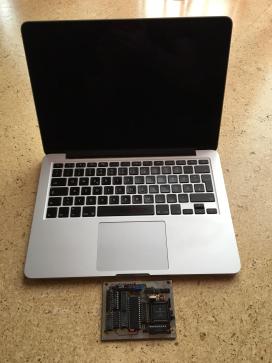|
|   
|
Early days (1990..1998)Thomas Nau: I for myself cannot share much beside how it originated. The three of us [Thomas Nau, Harald Daeubler, Bernhard Daeubler] studied Physics at about the same time and shared one hobby: building computers or some smaller digital electronic devices. Add ons for static memory for C64, hard disk interfaces, a tuned Atari ST1040 ... All of this needed support tools and devices such as PAL, later GAL, programming devices and more. At the very beginning manually drawing the boards or was sufficient like was using tiny sticky tape elements. It became much much harder when we went double-sided at the next project step. While planning for a full home grown system with bus, CPU board (Motorola MC 68020/30/40), graphics (WD controller), floppy and SCSI drive it became obvious that we would need a better tool which was when I started the PCB project. The time being on the ST we all owned. First using the API for drawing lines it became obvious that only passing by using own Assembler routines would be sufficient to get up to speed.
Over time we got access to more powerful UNIX systems at the University, lots of different flavors, which triggered the port to different operating systems like the BSDs, Solaris and Linux/FreeBSD we had at home now. The Atari area had ended as did our [CPU board] project. We simply couldn't keep up with increasing clock speed and haven't had access to the high end electronic devices needed for debugging. Still, the prototype went live. Not as full featured and stable as wanted but it booted. All the features we added over the years, up to Gerber support, were just driven by our needs or by contribution of others. Another benefit was the large variety of OSes we had access to. Getting it to run on all of those taught us several lessons on portable coding. Something which seems to have go lost over the last decade. Compiling "modern" code is sometimes just a pain with lots of dependencies if not running some mainstream OS Dan McMahill: I'm not going to be able to help with that era [of the '90s]. I first tried out PCB in the early 90's (pretty sure I have that time frame correct) and at that time it didn't have a rats nest and to me that was my threshold for even considering it. The competing tool at the time for me was MacDraw (a 2-D drawing tool that of course had no connectivity info, couldn't produce RS274 output, and was only useful for home made iron or photo transfer boards). In '93 I went to work full time as an electrical engineer doing board level design but using commercial EDA tools. I did not look at PCB again until late 2002. By then I'd switched from board level design to IC design and had a need for a quick turn around board and had been spoiled by nearly a decade of access to commercial EDA tools (Cadnetix and later P-cad) but at that point no longer had access to them. I was involved with open source software largely as a NetBSD developer working on their 3rd party packaging system (pkgsrc). I started looking around and asking on some mailing lists and heard that pcb was still the opensource tool but that in the decade since I'd last looked at it, the rats nest and connectivity driven layout was added as well as the ability to generate files I could send to a commercial board house. Those were the two features which were deal breakers for me if they had been missing. So I decided to give it a try. | ||||||||||||
   
| ||||||||||||||
| (C) 2016..2024 Various PCB developers/maintainers and Tibor 'Igor2' Palinkas; see copying for more details. | ||||||||||||||



